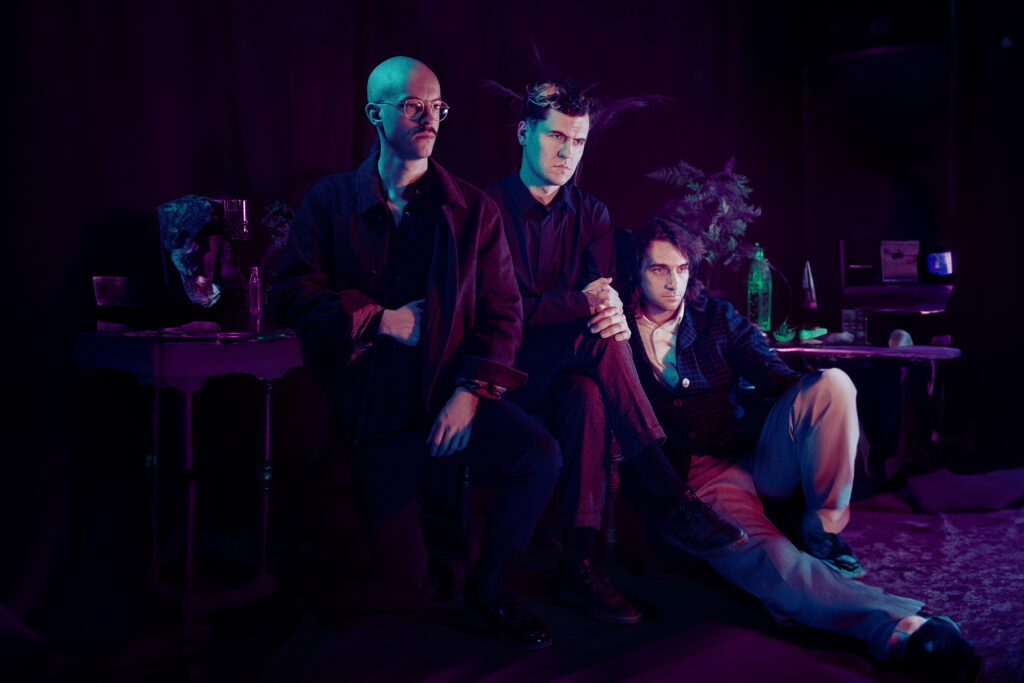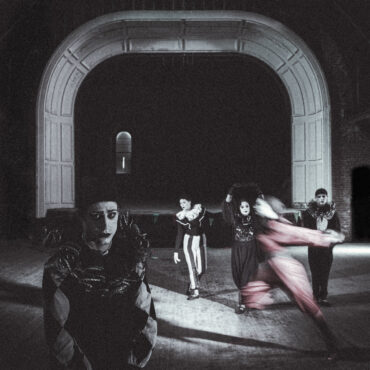
Photo by Eric Bones
The first sound we hear on “Before the Line” – the opening track from House of Harm’s new album Playground, which the band released last Friday – is the faint shimmer of a synthesizer, before we are ushered into a world of tight, rapid drum beats; winding, jangling guitars; and glittery, spacious synths. Though it lasts for a mere second, it carries a certain gravitas; it compels you inwards. It’s almost vocal in its sound, like a human cry filtered through a digital sieve. The main riff that the song builds around feels like a cue out of the Cure’s book. If the song was slower, it might feel like an outtake from the Wish era, the peak of Robert Smith and co.’s jangle pop years.
House of Harm is comprised of Michael Rocheford, Tyler Kershaw, and Cooper Leardi. Rocheford and Kershaw joined me on a Zoom call a few weeks before the album’s release to discuss what went into the making of these 10 songs. We had only met once before, a brief encounter at the 2022 Boston Music Awards ceremony. As a big fan of post-punk in general (and Vicious Pastimes specifically), I wanted to say hi and express an interest in talking to them at some point. “Did you have the same hair back then?” Kershaw asks, noticing my recently-shaven cue ball head. “I always remember a fellow bald guy.”
My biggest takeaway from speaking with them on that night came right after I expressed a love for post-punk. The band replied that while they also share that interest, a good deal of their favorite music falls outside that genre label. While they did mention a few post-punk stalwarts – The Cure (Rocheford was wearing their sweatshirt on the call), Interpol – I was curious to inquire what other genres were informing their songwriting. I took a stab in the dark by throwing out names like the Byrds and New York Dolls because Vicious Pastimes has a certain glittery quality, especially in the guitar production, that reminded me of those two groups. While the band doesn’t directly cite them as influences, they did make the keen observation that those two groups were very influential to early post-punk and alternative bands. The Byrds’ jangly, psychfolk arpeggios were a key point of reference for signature guitar styles of The Smiths’ Johnny Marr and R.E.M.’s Peter Buck, two groups that Rocheford and Kershaw did cite as influences during our interview. Other artists they’ve been listening to recently include the Drums and Paula Cole.
During the recording of Playground, however, the band wasn’t overly concerned – or maybe just too busy – with listening to music by other artists. “It was kind of hard to get into other music because we were just so immersed in [making Playground],” Rocheford explains. “You find yourself kind of just relating what you’re doing, like what you’re working on when you listen to any kind of music and you’re thinking about it all the time. So I feel like I haven’t even really been listening to music just for the sake of it.”
This full immersion into the recording process also applies to the album’s thematic content. While the band certainly had a visual vibe in mind (more on that later), it’s still a little too soon for the band to be able to give any sort of objective description as to the meaning of the songs and the album’s themes as a whole. “It’s a little bit close for us, I mean for me anyway, to kind of analyze like what’s the theme,” says Rocheford. “But it’s something that I’m noticing now more so than six months ago. I think I’ll be able to better answer that question maybe in like a year or two from now when I can kind of move on. I think from a musical standpoint, there are specific sounds that we used throughout the record that were important.”

Playground Album Art
While the lyrical themes may be left to the listener to unpack, the visual themes surrounding the album are quite distinct. Rocheford and Kershaw get noticeably excited when I bring the subject up. The album, as well as the two pre-release singles “Roseglass” and “Two Kinds,” feature photos from a shoot the band did based on drawings that Rocheford conceived. The models involved with the shoot are dressed in a distinct makeup and costume combo that makes them look like old-timey clowns, even if they weren’t necessarily clowns in Rocheford’s mind. “We’ve just been calling them the playground characters and I think that’s kind of maybe to protect the integrity of what it is because when we were talking about the artwork, we started talking about it before the demos were done.” The preproduction phase of this photoshoot involved a lot of D.I.Y. creativity for the band, from Rocheford’s rough drawings, costume design, vintage shopping, location scouting, model casting, and finding seamstresses and makeup artists. The models were in such appearance-altering makeup that at the end of the day, when all of that was removed, the band couldn’t believe these were the same people they had just spent an entire day with.
It does seem like a cohesive visual theme to match the songs was critical to House of Harm. After all, they had to put in a lot of deliberation to narrow down the tracklist to these 10 songs that they felt matched the essential energy of what they had in mind, as well as matching the aesthetic of the visual element that they wanted to implement. Rocheford says they wrote about 10 albums worth of material; Kershaw says it was around 70 songs. Even if only a fraction of those were inevitably keepers, that is nonetheless a highly prolific level of songwriting.
One trademark characteristic of the band’s music – evident on Vicious Pastimes and continued on Playground – is the drumming. For a band that doesn’t have an official drummer, the percussion plays a central role in their songs. It’s the driving pulse that lends House of Harm’s music a distinct danceable quality. Although none of the members are dedicated to the instrument, the drums on recordings are a mix of live playing and programmed percussion sequences. Kershaw played most of the drums on Playground. Programming isn’t something they want to have an over-reliance on, so even when they use a synthetic drum machine, they’ll still opt to fiddle with it by hand. “It seems like it’s the easier route to program the drums,” Rocheford explains, “but it’s hard to make them sound and feel right. There’s an unpredictability to like the human element that just adds something. Anything too crisp can feel, I don’t know, like an uncanny valley kind of thing.”
Keep an eye out for House of Harm to release tour dates to promote the new album; they’ve definitely got a show as part of Dark Spring Festival as far out as April 13th, 2024, so keep that on your calendar. You can stream Playground below.
